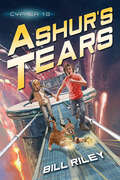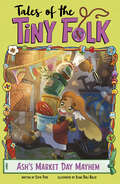- Table View
- List View
Ashtabula: People and Places (Images of America)
by Evelyn Schaeffer Richard E. StonerPost-World War II Ashtabula was a major Great Lakes port with a thriving downtown. Local photographer Richard E. Stoner began taking photographs of the growing city in 1938, and for the next 58 years, his lens captured Ashtabula's businesses, industries, and citizens. His commercial accounts ranged from the harbor's Pinney Dock and Transport Company, to Main Avenue's locally-owned Carlisle-Allen Company department store, to Ashtabula's major war industries. Dick Stoner's earlier photographs capture the Ashtabula that once was, including the week-long Sesquicentennial Celebration of 1953. His later photos record the beginnings of fundamental change in our way of life. Also included in this volume are some pre-1930s photographs by Vinton N. Herron, whose work Stoner purchased when Herron retired. For Ashtabulans, this is a family album. For others, it is a look at a bygone time in Midwest America.
Ashtamga Yoga: Yoga in the Tradition of Sri K. Pattabhi Jois (The Definitive Primary Series Practice Manual)
by Petri RaisanenThe most physical and dynamic form of yoga, Ashtanga combines an impressive sequence of yoga poses with special breathing techniques to heat the body internally and allow safe stretching of the muscles. Ashtanga's enthusiasts point to the powerful impact of the practice on their overall health and well-being: regular practice tones and strengthens the muscles, cleanses the body of toxins, calms the mind and increases concentration.
Ashtanga Yoga
by Gregor MaehleAshtanga Yoga: Practice and Philosophy is the first book of its kind, presenting a comprehensive guide to all eight limbs of Ashtanga Vinyasa Yoga. Join author Gregor Maehle, a seasoned yogi and compassionate teacher, as he guides you through: * the history and lineage of yoga * the fundamentals of breath, bandhas (energy locks within the body), drishti (the focal point of the gaze), and vinyasa (sequential movement) * a detailed breakdown of the asanas of the Ashtanga Primary Series, following the traditional vinyasa count * a lively and authentic rendering of the complete Yoga Sutra of Patanjali, yoga's ancient sacred text * a glossary of yoga terminology In the asana section, Maehle describes each posture with clear, meticulous instructions, photographs, anatomical illustrations, and practical tips. Information on the mythological background and yogic context of specific postures brings further insight to the practice. In the philosophy section, Maehle illuminates the Yoga Sutra using the major ancient commentaries as well as his own insights. This volume makes the entire path of Ashtanga Yoga accessible to modern practitioners. Both practical guide and spiritual treatise, Ashtanga Yoga is an excellent introduction to the eight limbs of yoga and an invaluable resource for any yoga teacher or practitioner.
Ashtanga Yoga - The Intermediate Series: Mythology, Anatomy, and Practice
by Gregor MaehleIn this much-anticipated follow-up to his first book, Ashtanga Yoga: Practice and Philosophy, Gregor Maehle offers a detailed and multifaceted guide to Ashtanga Yoga’s Intermediate Series. An expert yogi and teacher, Maehle will guide you to your next level with an unprecedented depth of anatomical explanation and unparalleled attention to the practice’s philosophical and mythological heritage. You will learn: • The background and applications of each of the three forms of yoga: Karma, Bhakti, and Jnana • How to use Indian myth and cosmology to deepen your practice • The importance of the Sanskrit language to the yogic tradition • The mythology behind the names of the Intermediate Series postures • The functions and limitations of body parts integral to the Intermediate Series, including the spine, the sacroiliac joint, the shoulder joint, and the hip joint • How to reap the full benefits of practicing the Intermediate Series Maehle meticulously explores all twenty-seven postures of the Intermediate Series through photos, anatomical line drawings, and practical, informative sidebars. He also discusses the philosophical and spiritual background of Ashtanga Yoga and places the practice within the context of Indian cultural history. With passionate erudition, Maehle will prepare you to reap physical, spiritual, and mental fulfillment from your evolving practice.
Ashtanga Yoga Primer
by Baba Hari DassAshtanga Yoga, also known as Raja Yoga, is the scientific method of enlightenment propounded by the sage Patanjali in his Yoga Sutras. Baba Hari Dass has been active in training students and teachers of yoga in the United States and Canada. Through his compassionate example, young and old alike are learning the gentle art of living in peace.
Ashtanga Yoga The Practice Manual: A Simplified Guide For Daily Practice
by David SwensonWhether new to Ashtanga or an experienced student or teacher, readers will find this book to be invaluable. It contains over 650 photos and multiple variations for every asana in the primary and intermediate series plus three short forms. Its spiral binding assures easy use while practicing and the hard cover increases durability.
Ashtanga Yoga: The Definitive Step-by-step Guide To Dynamic Yoga
by John Scott Shri K.Pattabhi JoisJohn Scott's Ashtanga Yoga is a step-by-step illustrated guide that takes you through the balanced exercise routines and breathing techniques of this dynamic form. Carefully structured, this course starts with a simple sequence for beginners which, once mastered, provides the foundation for moving on to the next level.- Purify your body with dynamic movement and precise postures- Develop physical and mental strength, increased stamina and greater flexibility- Includes a foreword by Shri K Pattabhi Jois, founder of Ashtanga Yoga- This new edition has been fully revised and updated This essential guide is the perfect introduction to yoga or the ideal gift for those who want to take their yoga practice to the next level.Author John Scott studied with yogi Shri K Pattabhi Jois at the Ashtanga Yoga Research Institute in India, where he qualified to teach Ashtanga Yoga around the world. He has instructed many people in Ashtanga Yoga, including high-profile celebrities Madonna and Sting. John now spends much of his time teaching international workshops and undertaking teacher trainings.
Ashtanga Yoga: The Essential Step-by-step Guide to Dynamic Yoga
by John ScottJohn Scott's Ashtanga Yoga is a step-by-step illustrated guide that takes you through the balanced exercise routines and breathing techniques of this dynamic form. Carefully structured, this course starts with a simple sequence for beginners which, once mastered, provides the foundation for moving on to the next level.- Purify your body with dynamic movement and precise postures- Develop physical and mental strength, increased stamina and greater flexibility- Includes a foreword by Shri K Pattabhi Jois, founder of Ashtanga Yoga- This new edition has been fully revised and updated This essential guide is the perfect introduction to yoga or the ideal gift for those who want to take their yoga practice to the next level.Author John Scott studied with yogi Shri K Pattabhi Jois at the Ashtanga Yoga Research Institute in India, where he qualified to teach Ashtanga Yoga around the world. He has instructed many people in Ashtanga Yoga, including high-profile celebrities Madonna and Sting. John now spends much of his time teaching international workshops and undertaking teacher trainings.
Ashton Hall
by Lauren BelferAn American woman and her son stumble upon the dark history of a rambling English manor house in this &“masterful, riveting, and atmospheric&” (Alka Joshi, author of The Henna Artist) novel from New York Times bestselling author Lauren Belfer. &“With vibrant prose, Lauren Belfer shepherds us through a centuries-old mystery and into a modern-day introspection on motherhood, marriage, and love.&”—Georgia Hunter, New York Times bestselling author of We Were the Lucky Ones When a close relative falls ill, Hannah Larson and her young son, Nicky, join him for the summer at Ashton Hall, a historic manor house outside Cambridge, England. A frustrated academic whose ambitions have been subsumed by the challenges of raising her beloved child, Hannah longs to escape her life in New York City, where her marriage has been upended by a recently discovered and devastating betrayal.Soon after their arrival, ever-curious Nicky finds the skeletal remains of a woman walled into a forgotten part of the manor, and Hannah is pulled into an all-consuming quest for answers, Nicky close by her side. Working from clues in centuries-old ledgers showing what the woman&’s household spent on everything from music to medicine; lists of books checked out of the library; and the troubling personal papers of the long-departed family, Hannah begins to recreate the Ashton Hall of the Elizabethan era in all its color and conflict. As the multilayered secrets of her own life begin to unravel, Hannah comes to realize that Ashton Hall&’s women before her had lives not so different from her own, and she confronts what mothers throughout history have had to do to secure their independence and protect their children.&“Infused with the brooding, gothic atmosphere of Jane Eyre or Rebecca&” (Melanie Benjamin, author of The Children&’s Blizzard) and rich with female passion, strength, and ferocity across the ages, Ashton Hall is a novel that reveals how the most profound hauntings are within ourselves.
Ashton Kutcher
by Marc ShapiroYou first dug him on That '70s Show. You daydreamed you'd somehow be part of one of his outrageous hoaxes on Punk'd. And The Butterfly Effect gave you butterflies in your stomach. Now here's the inside scoop on America's most glamorous and adorable goofball-turned-superstar -- a biography of Ashton Kutcher that asks the important questions, like whether he's just one lucky dude or one of the savviest entertainers of his generation. You be the judge. From his humble beginnings in Cedar Rapids, Iowa, to his early days as a model, to how he landed the role of Mike Kelso on the hit sitcom That '70s Show, here is everything you ever wanted to know about Ashton Kutcher. Find out why he studied biomedical engineering in college, why he pretended to end the run of the MTV show in which he'd punk'd his way to the top, and why he's so hellbent on landing dramatic roles. Here's the dish on his family, his outlook on life, his controversial relationship with megastar Demi Moore...and more -- like all the basics: stats, quirky habits, you name it. Featuring fantastic photos and cool quotes, Ashton Kutcher: The Life and Loves of the King of Punk'd -- like Ashton himself -- has it all! It's a must-have for any fan.
Ashton's Bride
by Judith O'BrienMargaret Garnett, too tall, too smart, and much too much a Northerner, felt as if she were being watched from the moment she arrived to teach at Tennessee's Magnolia University. The feeling became a shivery chill when she moved into Rebel's Retreat, the historic cottage built by Confederate General Ashton Johnson. But the shock of seeing the general's portrait and recognizing him as the man of her most passionate fantasies left her with an eerie certainty -- that somehow his ghost was actually there. Soon Margaret was reading old letters and devouring every fact on the dashing Ashton, his engagement to a fickle beauty who may have been a spy, his death at the hands of a Union sharpshooter. But nothing prepared Margaret for the fever, the dizziness, and the shock of waking up in a vanished era -- in Ash's arms. Suddenly alive in a South of scorched earth and tears, she knew this was where she had always belonged...where she had been sent to alter the course of war itself, to embrace a destiny time could not stop and a love death could not deny....
Ashton's Dancing Dreams (Faithgirlz / The Daniels Sisters #2)
by Kaitlyn Pitts Camryn Pitts Olivia PittsA new city. A new school. New friends. The Daniels sisters have been slowly rebuilding their lives after their mother’s death. Ansley’s the baker. Amber’s the volleyball player. Ashton "Cammie" Daniels has fallen in love with dancing. There’s nothing she loves better than attending dance class with her two friends, Rani and June. But that joy is in jeopardy when Rani’s father announces they may be moving to London. When she finds out about the school's spring talent show, Ashton thinks that if she and her friends enter and dance, Rani's parents will think twice about taking their daughter away from her home, friends, and activities. But her dreams begin to fall apart when the group can't agree on music, costumes, or choreography! Cammie has an important decision to make: stick it out for Rani's sake, go off on her own, or close the curtain for good on her dream to dance. Ashton’s Dancing Dreams—Is the second book in the Daniels Sisters Faithgirlz fiction seriesFeatures diverse characters any tween girl can relate toWritten by the daughters of beloved author and speaker Wynter PittsIs an engaging read for girls ages 8-12 Includes illustrationsIs a perfect gift for tween girls, and is great for Spring Break and summer vacation reading
Ashton-Under-Lyne in the Great War (Your Towns & Cities in the Great War)
by Glynis CooperA new book on Ashton-under-Lyne during World War I is being published as part of a series on Towns and Cities in the Great War to commemorate the centenary of the beginning of the War. It focuses on the economic and social conditions, problems and hardships of those left at home in England played out against a background of military action on the Western Front, in Turkey, Egypt and Palestine. Ashton was both a garrison town and a mill town. There were three Battalions based locally and over 1500 local men lost their lives. Sir Max Aitken, later Lord Beaverbrook, was Liberal Unionist MP for Ashton. In the summer of 1917 five tons of TNT exploded at an Ashton munitions factory destroying mills and houses, setting gasometers on fire and hurling acid drums into the river. Fifty people died and five hundred were injured. The book chronicles the difficulties, hardships, restrictions and morale of the town year by year as the War dragged on; the constant fear of Zeppelin raids; and the determined spirit of the folk of Ashton that the Kaiser would not beat them.
Ashur's Tears
by Lt. Col. Bill RileyToby Cypher has it pretty good. He's on the cusp of success with his mimics (programmable morphing robots indistinguishable from humans), he has a side gig volunteering at the Air Force Museum, and he's tutoring the prettiest, coolest girl in school. Toby's world falls apart when he learns that his father-Dr. Erasmus Cypher, a scientist who does classified work for the government-has gone down in a plane crash over Iraq. But Toby's sister Katie soon uncovers a secret message on their dad's smart phone-a message sent after the plane crashed. Toby and Katie are drawn into the dizzying world of their father's secret work, a world of untold danger and profound mysteries, where the two siblings will need all their wits just to survive. Science meets magic in award-winning author Bill Riley's debut fiction novel, Ashur's Tears, the fast-paced, intricately plotted first installment in the Cypher series.
Ashwagandha for Quality of Life: Scientific Evidence (Sustainable Industrial and Environmental Bioprocesses)
by Renu Wadhwa Sunil KaulThis book offers a comprehensive overview of the scientific evidence supporting the diverse health benefits of Ashwagandha. Each chapter delves into specific aspects, exploring its effects on stress management, cognitive function, physical performance, immune system support, sleep quality, and hormonal balance. Through an evidence-based approach, the text aims to bridge the gap between traditional wisdom and modern scientific understanding, presenting Ashwagandha as a promising herb for enhancing quality of life. Ashwagandha for Quality of Life: Scientific Evidence begins by highlighting the origin and botanical characteristics of Ashwagandha and explores the wide range of its traditional and modern applications. By identifying the main active compounds and their functions, readers gain insight into the herb's potential physiological effects. Further, the book investigates Ashwagandha's potential for preventing and treating COVID-19. The book is intended for general readership, herbalists, naturopaths, alternative medicine practitioners, and life science/medical students and researchers to gain a comprehensive understanding of Ashwagandha's potential in improving health and well-being, while also emphasizing the importance of quality and chemotyping for optimal benefits.
Ashworth Hall: A Charlotte and Thomas Pitt Novel (Charlotte and Thomas Pitt #17)
by Anne PerryWhen a group of powerful Irish Protestants and Catholics gather at a country house to discuss Irish home rule, contention is to be expected. But when the meeting’s moderator, government bigwig Ainsley Greville, is found murdered in his bath, negotiations seem doomed. Unless Superintendent Thomas Pitt and his wife, Charlotte, can root out the truth, simmering hatreds and passions may again explode in murder.
Ashworth Hall: Politics and murder entwine in Victorian London (Thomas Pitt Mystery #17)
by Anne PerryCan Pitt solve the case before the killer strikes again? The murder of a prominent politician has links to Irish civil unrest in Anne Perry's gripping Victorian mystery, Ashworth Hall. Perfect for fans of C. J. Sansom and Sarah Perry.'Elegant period novel with a contemporary resonance' - Guardian When a group of powerful Irish Protestants and Catholics gather at a country house to discuss Irish home rule, contention is to be expected. But when the meeting's moderator, government bigwig Ainsley Greville, is found murdered in his bath, negotiations seem doomed. Unless Superintendent Thomas Pitt and his wife, Charlotte, can root out the truth, simmering hatreds and passions may again explode in murder. What readers are saying about Anne Perry: 'The atmosphere of turn of the century London is so absorbing and tangible that you can almost feel yourself shrouded in a cold blanket of East End fog and hear the Hansom carriages clatter along the streets''These are a great set of books. Pitt is a really likeable hero''Five stars'
Ash’s Cabin
by Jen WangAsh has always felt alone.Adults ignore the climate crisis. Other kids Ash’s age are more interested in pop stars and popularity contests than in fighting for change. Even Ash’s family seems to be sleepwalking through life.The only person who ever seemed to get Ash was their Grandpa Edwin. Before he died, he used to talk about building a secret cabin, deep in the California wilderness. Did he ever build it? What if it’s still there, waiting for him to come back…or for Ash to find it? To Ash, that maybe-mythical cabin is starting to feel like the perfect place for a fresh start and an escape from the miserable feeling of alienation that haunts their daily life.But making the wilds your home isn’t easy. And as much as Ash wants to be alone…can they really be happy alone? Can they survive alone?From New York Times–bestselling author and illustrator Jen Wang comes a singularly affecting story about self-discovery, self-reliance, and the choice to live when it feels like you have no place in the world.
Ash’s Market Day Mayhem (Tales Of The Tiny Folk Ser.)
by Steve FoxeTiny Folk from all across the land (i.e., the neighborhood) are coming together for market day! This year, friends Ash and Pon are hosting the big event in a shed their human neighbors never seem to use. The only problem? It’s a mess! Ash volunteered without checking the place first. Can she, with a little help, corral the clutter and get everything ready for an unforgettable festival? In Tales of the Tiny Folk, follow along as itty-bitty creatures use creativity to thrive in a world that’s not quite their size. With manga-inspired art and lighthearted adventure, young readers will snap up these super-cute graphic novels that are big fun!
Asi Paso En Iran
by SiscoEl 11 de febrero de 1979 Ayesha estaba en el aeropuerto de Teherán empujando a cientos de miles de personas para que el ayatola Jomeini no aterrizara? Porque después de haber vivido con la monarquía de Reza Pahlevi sabía cómo el religioso fundamentalista, con el Corán a cuestas, iba a tratar a la mujer iraní. Por esa razón esta feminista persa y su hija estuvieron «activas» toda la vida.
Asi Se Dice! Level 1 (Asi Se Dice)
by Conrad J. SchmittThis is the textbook for level 1 of the popular Spanish language learning series
Asi se dice! (Level 4)
by Schmitt McGraw Hill¡Así se dice! helps you teach Spanish your way with manageable content and easy-to-use technology. Cultural and interactive experiences blend learning opportunities to transport students to the exciting diverse world of Hispanic culture.
Asi somos los espanoles: Spanish Skills for Advanced Students
by Peter Furnborough Concha Pérez Valle Michael TrumanAsí somos los españoles provides advanced students with a genuine insight into Spanish culture via a range of practical activities and exercises. The courses includes many unscripted recordings of interviews with Spaniards from a variety of geographical areas. Students explore these recordings through activities designed to develop listening, speaking, reading and writing skills.This course suitable for classroom use or independent learning.
Asia
by Arthur CotterellFrom one of the world's leading historians?a comprehensive narrative of the 3,000 years that have formed Asia's people, culture, and global destiny Tracing its origins in Mesopotamia to its modern role on the global geopolitical stage, historian Arthur Cotterell offers a compelling, lively, and readable account of one of the most culturally diverse, and often misunderstood, parts of the world. Beginning with the emergence of the world's earliest civilization in 3000 BC, Asia: A Concise History provides a fascinating look at the global convulsions?like the rise and fall of Assyria and Persia, the medieval states that flourished after the advent of Islam, and the modern transformations triggered by the lightning conquests of imperial Japan?that have shaped the continent. Covers the great events and figures of Asian history, along with a look at the monumental remains that bear witness to those times: the ziggurats of Iraq, the Taj Mahal, the Great Wall of China, the temple of Angkor Wat Includes fascinating slices of history, including funeral arrangements for Qin Shi Huangdi in 210 BC; an extract from Lord Macartney's journal of his 1793 diplomatic mission to the Qing emperor Qian Long; and Toyotomi Hideyoshi's edict of 1587 banning firearms in Japan Features boxed inserts of special interest?like a Babylonian recipe for lamb stew circa 1500 BC Contains over 100 illustrations, maps, and photos Other books by Cotterell: The Minoan World, The First Emperor of China, The Encyclopedia of Mythology, and Chariot Destined to become a reference staple for history buffs and students of Asian history, Asia: A Concise History offers readers a breathtaking narrative and wealth of detail that make the formative periods, key events, and personalities from this once remote part of the world come alive.























